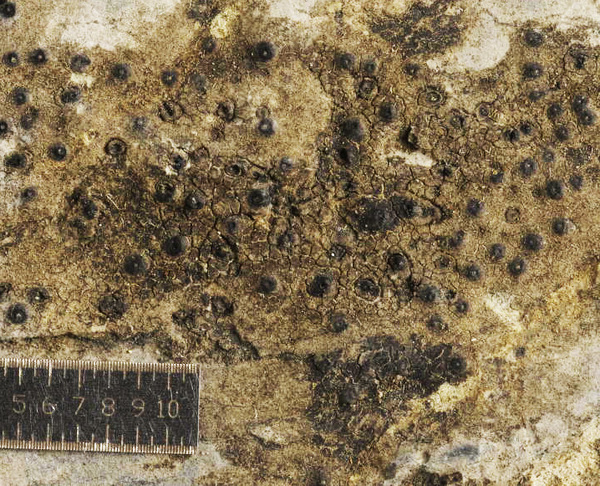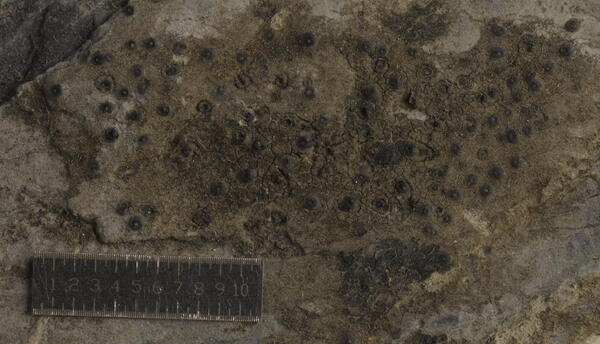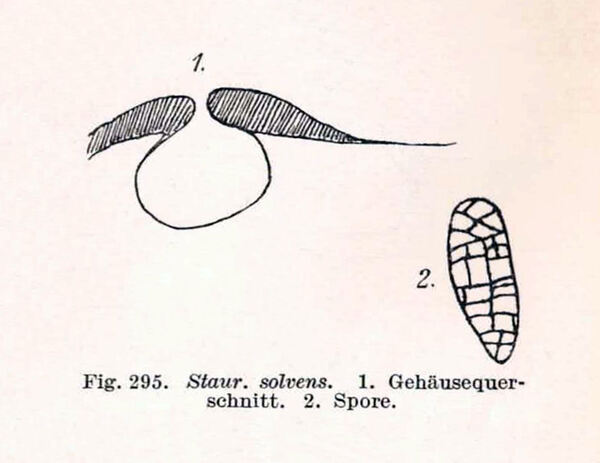Staurothele solvens (Anzi) Zschacke var. solvens
Hedwigia, 54: 195, 1913. Basionym: Polyblastia solvens Anzi - Comm. Soc. Critt. Ital., 2, 1: 27, 1864.
Synonyms: Staurothele meylanii B. de Lesd.; Staurothele solvens (Anzi) Zschacke
Distribution: N - TAA (Nascimbene & al. 2007b, 2022), Lomb.
Description: Thallus crustose, thinly episubstratic, finely rimose, smooth, pale brownish grey, sometimes with a pinkish tinge. Perithecia at first completely immersed in thallus, later projecting with the black, slightly pruinose, convex apical part, forming 0.6-0.8 mm wide projections. Exciple dark throughout, c. 450 μm across; involucrellum present, thick, limited to the apical part and widely spreading from the ostiolar region; hymenial algae more or less isodiametric; hamathecium of periphyses and periphysoids, interascal filaments absent. Asci 4-spored, clavate, the wall thickened above, with an ocular chamber, after dehiscence with a delicate extruded endotunica, I-, K/I-. Ascospores muriform, at first hyaline then orange-brown, ellipsoid, 40-82 x 18-32 μm. Photobiont chlorococcoid, present in both thallus and hymenium. Spot tests: K-, C-, KC-, P-, UV-. Chemistry: without lichen substances.Note: on limestone and dolomite, often along creeks in the alpine belt, only known from the south European mountains (Alps, Pyrenees). According to Roux & coll. (2014) the species can be subdivided into three well-distinct varieties.
Growth form: Crustose
Substrata: rocks
Photobiont: green algae other than Trentepohlia
Reproductive strategy: mainly sexual
Poorly known taxon in need of further study
Commonnes-rarity: (info)
Alpine belt: very rare
Subalpine belt: absent
Oromediterranean belt: absent
Montane belt: absent
Submediterranean belt: absent
Padanian area: absent
Humid submediterranean belt: absent
Humid mediterranean belt: absent
Dry mediterranean belt: absent

Predictive model
Herbarium samples

Natural History Museum (2014). Dataset: Collection specimens. Resource: Specimens. Natural History Museum Data Portal (data.nhm.ac.uk). https://doi.org/10.5519/0002965 Retrieved: 16:11 01 Jan 2021 (GMT)

Natural History Museum (2014). Dataset: Collection specimens. Resource: Specimens. Natural History Museum Data Portal (data.nhm.ac.uk). https://doi.org/10.5519/0002965 Retrieved: 16:11 01 Jan 2021 (GMT)
Growth form: Crustose
Substrata: rocks
Photobiont: green algae other than Trentepohlia
Reproductive strategy: mainly sexual
Poorly known taxon in need of further study
Commonnes-rarity: (info)
Alpine belt: very rare
Subalpine belt: absent
Oromediterranean belt: absent
Montane belt: absent
Submediterranean belt: absent
Padanian area: absent
Humid submediterranean belt: absent
Humid mediterranean belt: absent
Dry mediterranean belt: absent

Predictive model
| Herbarium samples |

Natural History Museum (2014). Dataset: Collection specimens. Resource: Specimens. Natural History Museum Data Portal (data.nhm.ac.uk). https://doi.org/10.5519/0002965 Retrieved: 16:11 01 Jan 2021 (GMT)

 INDEX FUNGORUM
INDEX FUNGORUM
 GBIF
GBIF
 DOLICHENS
DOLICHENS



